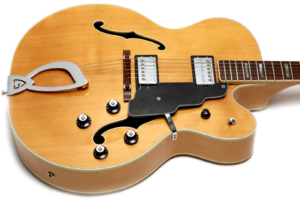 This big ol’ thick piece of blonde jazz box goodness is a 1983 Guild X175 guitar. I scored this gem from a user over on the Let’s Talk Guild forum who thought I might appreciate it and write it up. How could I say no, especially for the nice price he offered and the excellent condition of the guitar?
This big ol’ thick piece of blonde jazz box goodness is a 1983 Guild X175 guitar. I scored this gem from a user over on the Let’s Talk Guild forum who thought I might appreciate it and write it up. How could I say no, especially for the nice price he offered and the excellent condition of the guitar?
Follow along while I give this guitar the full review treatment right down to the wiring inside this big ol’ hollow box o’ jazz.
Introduction
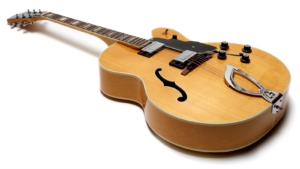 The Guild X175 has been around for a long time. The earliest catalog I have is from 1954 and so far as I know is one of the first to be released, and it contains an M175 guitar which is similar in design to the X175, thought it has Frequency Tested pickups and a master volume and tone. In the 1955 catalog, the guitar is called the Manhattan 175. In the 1959 and 1960 catalogs there is an X175 Manhattan model with controls more closely resembling the one seen in this article, though it would remain with Franz pickups for a few years. Note that the guitar currently being sold by Guild as the Newark St. X175 is closely based on the older Hoboken-made X175 which differs a fair bit from the X175 being discussed in this review.
The Guild X175 has been around for a long time. The earliest catalog I have is from 1954 and so far as I know is one of the first to be released, and it contains an M175 guitar which is similar in design to the X175, thought it has Frequency Tested pickups and a master volume and tone. In the 1955 catalog, the guitar is called the Manhattan 175. In the 1959 and 1960 catalogs there is an X175 Manhattan model with controls more closely resembling the one seen in this article, though it would remain with Franz pickups for a few years. Note that the guitar currently being sold by Guild as the Newark St. X175 is closely based on the older Hoboken-made X175 which differs a fair bit from the X175 being discussed in this review.
Around 1964 or so, the catalog started showing the same old picture of the Franz-equippend X175, but now with an overlay showing that the guitar included Anti-Hum pickups, Guilds first foray into the world of humbuckers. Those Anti-Hum pickups would remain in the guitar (along with most of the electric guitars in Guild’s lineup) until about 1971 when the catalog starts saying that the X175 Manhattan comes with Guild’s new humbucking pickups, likely referring to the large HB1s that were to be the Guild standard offering for many years.
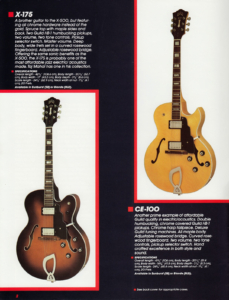 By 1975, the guitar shown in the catalog very much resembled the guitar being reviewed here, though with a beautiful sunburst finish. The 1983 catalog also shows the beautiful sunburst version of the X175. The catalog from 1982 calls the X175 the brother guitar to the X500, but featuring all chrome hardware. It also says that, Offering the same sonic benefit as the X500, the X175 is probably one of the most affordable jazz electric/acoustics made.
By 1975, the guitar shown in the catalog very much resembled the guitar being reviewed here, though with a beautiful sunburst finish. The 1983 catalog also shows the beautiful sunburst version of the X175. The catalog from 1982 calls the X175 the brother guitar to the X500, but featuring all chrome hardware. It also says that, Offering the same sonic benefit as the X500, the X175 is probably one of the most affordable jazz electric/acoustics made.
The catalog states that the X175 was available in either sunburst as shown in the catalog, or blonde which is obviously the finish seen on the guitar being reviewed here. Finally, the catalog states that Taj Mahal has one in his collection, to which I thought, “Who the hell is Taj Mahal?”, perhaps cementing the fact that I’m not a jazz aficionado. After figuring that out, I spent some time trying to find a picture of him with his Guild X175 but was unable to do so.
I do not have a 1983 price list, but in the March 1981 price list, the X175 is listed for $1075 with an additional $122.50 for a flannel line case and $142.50 for a plush lined case.
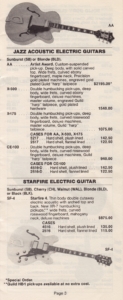 I’ve reviewed other Guild jazz guitars including the 1980s X500s, the and the 2001 X500T. Those guitars are loaded with flashy appointments that make them legitimate high-end guitars, though none of them have solid carved tops, with that feature having been reserved for the very pricey Artist Award model and later the X700.
I’ve reviewed other Guild jazz guitars including the 1980s X500s, the and the 2001 X500T. Those guitars are loaded with flashy appointments that make them legitimate high-end guitars, though none of them have solid carved tops, with that feature having been reserved for the very pricey Artist Award model and later the X700.
The X175 is more of a working-man’s jazz guitar in that it doesn’t have the fancy v-block inlays or magnificent wood grain of the X500s. The X500s also have gold-played hardware and the beautifully ornate harp tailpiece. The lack of those features doesn’t make this a lesser guitar in my book, though one could argue that the higher models probably used better wood. I could counter-argue that the wood is largely laminate on all of these models and so what you get with the X500s is mostly bragging rights. The X500s did have ebony fretboards where the X175 is rosewood, so the differences are not just flash, but if ever there was a guitar that wanted to prove itself the equal of its well-dressed brethren, this X175 is it.
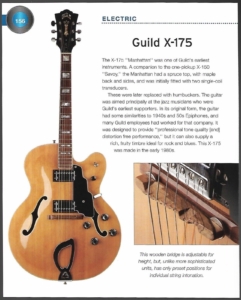 This image is a scan of page 156 from the book The Illustrated Catalog of Guitars by Nick Freeth, showing the exact same photo and information as seen on this website. I stumbled upon this picture while looking for something else and was struck by how much the pictured guitar looks like the X175 in my possession and then proceeded to spend almost an entire day trying to figure out what book it was from so that I could buy a copy.
This image is a scan of page 156 from the book The Illustrated Catalog of Guitars by Nick Freeth, showing the exact same photo and information as seen on this website. I stumbled upon this picture while looking for something else and was struck by how much the pictured guitar looks like the X175 in my possession and then proceeded to spend almost an entire day trying to figure out what book it was from so that I could buy a copy.
If you ever wondered if I was as detail oriented, obsessive, and compulsive in real life as I am with these reviews, well I suppose there’s your answer.
The case
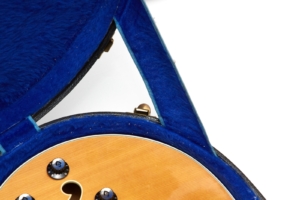 The case for this X175 is quite deep measuring almost 6 ¾” from top to bottom which is a quarter-inch thicker than my ’90s X700 case. As is common on many well-worn cases, the handle on my example long ago broke off an was replaced, though at least on this case it wasn’t just replaced with gaffer’s tape.
The case for this X175 is quite deep measuring almost 6 ¾” from top to bottom which is a quarter-inch thicker than my ’90s X700 case. As is common on many well-worn cases, the handle on my example long ago broke off an was replaced, though at least on this case it wasn’t just replaced with gaffer’s tape.
If you read my review of my 1985 Guild D46, then you may recall my complaints about the case that had an odd sort of fabric strip that seems intended to keep the case top from over-extending and ruining the hinges. Well this guitar, being from the same era, seems to have the same awful design along with the similarly often inclusion of the locking briefcase latch commonly seen in the ’70s and ’80s.
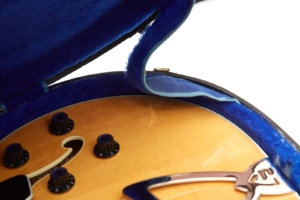 The problem with the strap is that it needs to go somewhere when the lid closes, which means it either folds up on the guitar (which seems like a bad idea) or sticks out the side of the case making it difficult to close. Being comprised from the same material as the case lining, it’s unlikely that the strap would cause any finish issues, but what I don’t like is that extra strap being forced down unto the top because that could lead to uneven wear. Luckily, the default behavior after many years seems to be for the strap to stick out when closing the lid which, as expected, makes the case difficult to close. Thankfully Guild eventually did away with these dumb straps.
The problem with the strap is that it needs to go somewhere when the lid closes, which means it either folds up on the guitar (which seems like a bad idea) or sticks out the side of the case making it difficult to close. Being comprised from the same material as the case lining, it’s unlikely that the strap would cause any finish issues, but what I don’t like is that extra strap being forced down unto the top because that could lead to uneven wear. Luckily, the default behavior after many years seems to be for the strap to stick out when closing the lid which, as expected, makes the case difficult to close. Thankfully Guild eventually did away with these dumb straps.
Finish
My gut tells me this guitar is finished in poly. It’s from 1983 and doesn’t have a single lacquer check on it and that makes me suspicious. Plus, the guitar does not really glow under UV light. While all of the late-70s Guild electric guitars I’ve owned have been clearly finished in lacquer, in the early-mid ’80s many Guild electric guitars were coated in poly as clearly seen by the wear pattern on guitars I’ve reviewed like the X79-3 Skyhawk, and the S284 Aviators. While those guitars had a much thicker, candy-like coating on them, this X175 does not give that same impression which leads me to state that the finish doesn’t really matter, at least on this guitar.
Fretboard and Neck
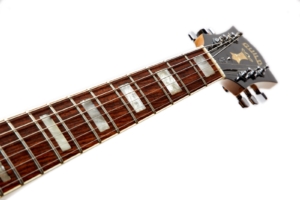 The scale length on this X175 is 24 ¾” and the frets, advertised in the catalog as wide, are jumbos measuring .04″ high by .105″ wide. The fretboard is described as curved in the catalog, and it measures a radius of 9.5″ which is indeed curved when compared with a 12″ radius. The fretboard is bound rosewood with block pearloid inlays which I think look great due to the beautiful variations visible in the material.
The scale length on this X175 is 24 ¾” and the frets, advertised in the catalog as wide, are jumbos measuring .04″ high by .105″ wide. The fretboard is described as curved in the catalog, and it measures a radius of 9.5″ which is indeed curved when compared with a 12″ radius. The fretboard is bound rosewood with block pearloid inlays which I think look great due to the beautiful variations visible in the material.
The neck measures a solid 1 5/8″ at the nut, and while I generally prefer wider necks, when it comes to 1 5/8″ fretboards, the depth makes all the difference to me, and since this guitar is .79″ deep at the nut I find the guitar to be quite comfortable while playing. I used to have a Starfire IV that was .73″ at the nut and it was just awful for me. It amazes me how much of a palpable difference .06″ can make.
The headstock shows the Guild logo with the Chesterfield inlay unlike the higher-end X500 and X700 models that sport the G-shield logo.
This guitar has a three-piece neck but I’ve seen ’70s models like this one with a five-piece neck. The neck seems rock solid to me and I’ve not had to adjust it at all. The neck wood is not flamed like it is on the higher-end models like the X500 and X700s, but again that’s part of this guitar’s personality being a working man’s jazz instrument.
Build Quality
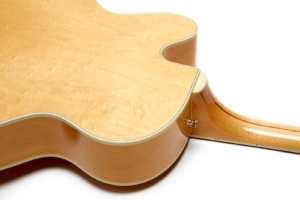 The build quality of this guitar is superb as I would expect from any Westerly-made Guild. Actually, I’ve never played a poorly built Guild. I’ve seen cosmetic issues on some of the import lines from Guild, but never an issue on any US-made model that I’ve ever seen.
The build quality of this guitar is superb as I would expect from any Westerly-made Guild. Actually, I’ve never played a poorly built Guild. I’ve seen cosmetic issues on some of the import lines from Guild, but never an issue on any US-made model that I’ve ever seen.
The neck joint is rock solid and of typical Westerly Guild quality, and the attention to detail in every facet of the build is as I’d expect from such a guitar. Though not a fancy guitar, I’d expect a US-made guitar of this quality to probably only come from a US custom shop these days, which says more about the state of US guitar manufacturing these days *cough* Gibson *cough* than it does about Guild in the ’80s.
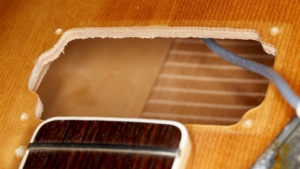 The top is laminate spruce just like on the X500s with solid spruce tops having been reserved for higher end guitars like the Artist Award and later X700 models. There are lengthwise braces under the top but they do not interfere with the pickup routes in any way.
The top is laminate spruce just like on the X500s with solid spruce tops having been reserved for higher end guitars like the Artist Award and later X700 models. There are lengthwise braces under the top but they do not interfere with the pickup routes in any way.
The guitar is a hollow-body design and weighs a surprising 8 lbs 12 oz (3.97 kilos) but instead of giving the impression of being overly heavy, the guitar gives the impression of being a tough well-built instrument. The reasons for the weight are partly due to the guitars depth and partly because of the sound block.
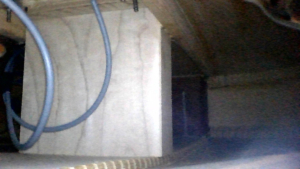 Though this guitar is hollow, there is a large sound block inside that connects the front and back in order to minimize feedback and presumably stabilize the top. That large block does add a fair bit of weight to the guitar, and while it does indeed limit feedback when compared to the X500 or X700 I’ve played without one, that feedback reduction comes at the expense of a noticeable deadening of the top while playing. It could be argued that you don’t feel or hear that while playing with a band, but a seasoned professional can feel their instrument and how it responds to them, so the tradeoff may or may not be worth the benefit depending on the player.
Though this guitar is hollow, there is a large sound block inside that connects the front and back in order to minimize feedback and presumably stabilize the top. That large block does add a fair bit of weight to the guitar, and while it does indeed limit feedback when compared to the X500 or X700 I’ve played without one, that feedback reduction comes at the expense of a noticeable deadening of the top while playing. It could be argued that you don’t feel or hear that while playing with a band, but a seasoned professional can feel their instrument and how it responds to them, so the tradeoff may or may not be worth the benefit depending on the player.
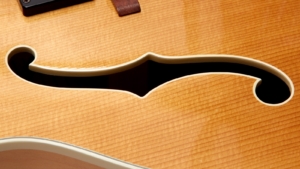 The top is beautiful with its fine evenly spaced spruce grain. The f-holes are bound with a simple white binding devoid of obvious layers like you might find on a higher-end guitar. While this is a lower-than-X500 level of flash, it’s a touch higher than the later X170 Manhattan model which did not have bound f-holes. The top and back of the guitar is bound with what looks like a 5-layer purfling strip inside. Again, I think that this simple elegance really works on the guitar
The top is beautiful with its fine evenly spaced spruce grain. The f-holes are bound with a simple white binding devoid of obvious layers like you might find on a higher-end guitar. While this is a lower-than-X500 level of flash, it’s a touch higher than the later X170 Manhattan model which did not have bound f-holes. The top and back of the guitar is bound with what looks like a 5-layer purfling strip inside. Again, I think that this simple elegance really works on the guitar
Pickups
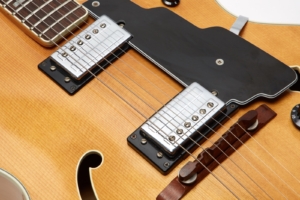 The pickups are the famous Guild HB1s that I love so much, and as expected they sound glorious. I’ve never heard HB1s sound bad in any guitar, but I think their chimey nature is very well balanced in a thick jazz box guitar like this. Although jazz players often prefer to comp chords with the tone rolled down on the neck pickup (and this guitar does that very well), the options of having brighter sounding choices allows this guitar to have a very nice variety of tones that work across multiple genres.
The pickups are the famous Guild HB1s that I love so much, and as expected they sound glorious. I’ve never heard HB1s sound bad in any guitar, but I think their chimey nature is very well balanced in a thick jazz box guitar like this. Although jazz players often prefer to comp chords with the tone rolled down on the neck pickup (and this guitar does that very well), the options of having brighter sounding choices allows this guitar to have a very nice variety of tones that work across multiple genres.
Electronics
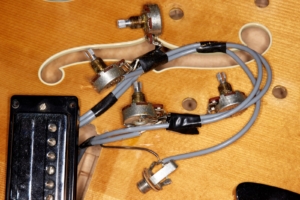 Being the detail-oriented insomniac that I am, I spent a couple of hours pulling the harness out of this guitar so that I could photograph it, trace it, and document it. I was glad that I did because it was tempting to assume that all of the pots were just 500k, but as you can see by the wiring diagram, that is not the case.
Being the detail-oriented insomniac that I am, I spent a couple of hours pulling the harness out of this guitar so that I could photograph it, trace it, and document it. I was glad that I did because it was tempting to assume that all of the pots were just 500k, but as you can see by the wiring diagram, that is not the case.
The tone pots are 200k, and note that I didn’t write 250k because they are, in fact, 200k. This is fairly common on Guild guitars, though the model and year can change what you might see, but if you’re used to modern Strats and such, don’t assume that there should be 250k pots in here, though to be fair the difference when considering tolerance may be slight.
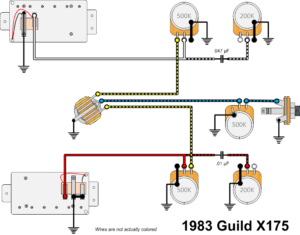 The neck tone circuit includes a .047 μF capacitor while the bridge tone circuit includes a .01 μF capacitor, both of which are green mylar caps that were commonly used on Guilds in this period.
The neck tone circuit includes a .047 μF capacitor while the bridge tone circuit includes a .01 μF capacitor, both of which are green mylar caps that were commonly used on Guilds in this period.
This guitar has the selector switch on the bottom bout where there is also a very Guild-like master volume knob that is smaller than the main control knobs. This master volume is nothing more than a 500k pot in-line just after the toggle switch and before the output jack.
All of the internal wiring is very well routed and wrapped up tightly using electrical tape. Tracing the wires can be a challenge because like all ’70s Guilds that I’ve seen, all of the wires are non-descript grey, but patience and a multimeter can be your friend if you find yourself needing to repair one of these guitars.
Hardware
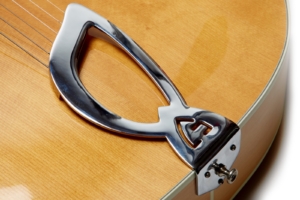 As stated in the catalog, the hardware on this guitar is all chrome. The beautiful harp tailpiece shows this off nicely and is one of the key differences between the X175 and the higher-end X500. The X500 has a very ornate 3-D pattern to it which really makes it pop whereas the X175’s tailpiece is simple in an elegant way that just works for me. I think the reasons why I like the look of this guitar so much is that I think it looks kind of like a very thick Starfire. A good friend played a late-’70s Starfire in high school that had the plain chrome harp tailpiece and the same sort of stunning but unflamed top that this X175 does. This is certainly a very different guitar, but visually it has the same appeal, at least to my eyes.
As stated in the catalog, the hardware on this guitar is all chrome. The beautiful harp tailpiece shows this off nicely and is one of the key differences between the X175 and the higher-end X500. The X500 has a very ornate 3-D pattern to it which really makes it pop whereas the X175’s tailpiece is simple in an elegant way that just works for me. I think the reasons why I like the look of this guitar so much is that I think it looks kind of like a very thick Starfire. A good friend played a late-’70s Starfire in high school that had the plain chrome harp tailpiece and the same sort of stunning but unflamed top that this X175 does. This is certainly a very different guitar, but visually it has the same appeal, at least to my eyes.
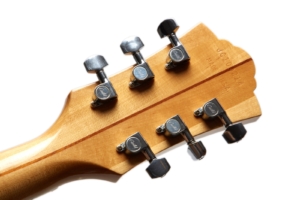 The tuners on this guitar are mini-tuners of the type you might find on a six-on-a-side guitar like a 12-string or a Fender Strat-type guitar. This is not the first guitar from this time period that I’ve owned with these mini tuners, and you can see in my review of my 1985 Guild D46 that it had the same goofy little tuners on it. I don’t understand the decision by Guild to put little tuners on such a big guitar, so I’m going to go ahead and assume that either they a) ran out of normal size tuners, b) had a surplus of mini tuners, or c) some executive decided that this would be the wave of the future. Earlier examples of Guild X175s that I’ve seen have normal sized tuners, so if the idea of little tuners on your jazz box offends you, know that you can hunt for an X175 from different years to get what you want.
The tuners on this guitar are mini-tuners of the type you might find on a six-on-a-side guitar like a 12-string or a Fender Strat-type guitar. This is not the first guitar from this time period that I’ve owned with these mini tuners, and you can see in my review of my 1985 Guild D46 that it had the same goofy little tuners on it. I don’t understand the decision by Guild to put little tuners on such a big guitar, so I’m going to go ahead and assume that either they a) ran out of normal size tuners, b) had a surplus of mini tuners, or c) some executive decided that this would be the wave of the future. Earlier examples of Guild X175s that I’ve seen have normal sized tuners, so if the idea of little tuners on your jazz box offends you, know that you can hunt for an X175 from different years to get what you want.
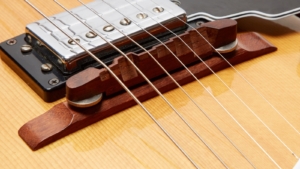 The bridge and saddle on this guitar are both rosewood which has a nice rich brown color to it that I like a lot. This is another difference between the X175 and the X500 because the X500 came with an ebony saddle and bridge. Does that affect the tone? I’m sure it does, but I certainly don’t hear anything that’s making me want to rush out and replace it with ebony, though to be fair my ear is generally complaining that whatever I’m playing needs more gain.
The bridge and saddle on this guitar are both rosewood which has a nice rich brown color to it that I like a lot. This is another difference between the X175 and the X500 because the X500 came with an ebony saddle and bridge. Does that affect the tone? I’m sure it does, but I certainly don’t hear anything that’s making me want to rush out and replace it with ebony, though to be fair my ear is generally complaining that whatever I’m playing needs more gain.
The strap pegs are generic and are in the proper spots for my tastes, being on the center of the bottom and on the upper bout right near, but not actually on, the neck heel.
One of the few things I dislike on vintage Guild hollow-bodies is the pick guard, which sits on top of the pickup rings and thus gets in my way when playing. I love the look of the stairstep guard, and I especially love that there’s no obnoxious logo on it, bit in theory that should be less of a problem on a guitar like this where (again, in theory) I’m not playing as aggressively as I might on a solid body guitar.
Sound
I loved the sound of the neck pickup with flat-wound strings, so naturally I did what any aging ’80s rocker would do and put round-wounds on. That’s when I discovered that I kind of disliked the sound of the neck pickup with round-wound strings. The bridge pickup is a rock monster, and to be totally fair I didn’t really dislike the tone from the neck pickup, but I will admit that it sounded much nicer with the flat-wounds. Options are a good thing, and knowing that the guitar can work well with either setup is a big plus in my book.
[dropshadowbox align=”right” effect=”raised” width=”” height=”” background_color=”#ffffff” border_width=”1″ border_color=”#dddddd” ]ODS100 Clean
7th Chords
Open Chords #1
Open Chords #2
D-Shape Plectrum
D-Shaped Finger
[/dropshadowbox]As usual, for these recordings I used my normal Axe-FX III through the QSC K12 speaker recorded direct into my Macbook Pro using Audacity. I recorded using the ODS100 Clean patch, and given that this isn’t really a guitar aimed at the rock genre, I opted not to record using the JCM800 or Citrus patches that I normally include.
For each recording I cycle through the neck pickup, both pickups, and finally the bridge pickup. All knobs on the guitar are on 10 at all times. Sadly, this is one of those guitars where no matter what I recorded I just didn’t feel as if I was doing the instrument justice. Sure, I could make it rock, and I could make it sing… in a rock song, and I could certainly appreciate what the guitar was trying to deliver, but the guitar responds so well that I just felt inadequate with it in my hands. That being the case, the guitar does inspire me to try and learn more Jazz in a way that some of the other jazz-oriented guitars I’ve owned didn’t. It’s really a wonderful instrument.
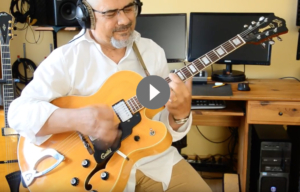 If you’d like to see someone who knows how to do a guitar like this justice, check out this video I found online of someone playing a vintage X175 like the one in my pathetic hands. This is one of those guitars that I feel a bit out of my element playing, but even while hacking my way through pathetic finger-style nonsense, the guitar seemed to beg me for more. That elusive inspirational quality is something that I find missing in a lot of modern guitars, especially those made overseas in an effort to meet a price point.
If you’d like to see someone who knows how to do a guitar like this justice, check out this video I found online of someone playing a vintage X175 like the one in my pathetic hands. This is one of those guitars that I feel a bit out of my element playing, but even while hacking my way through pathetic finger-style nonsense, the guitar seemed to beg me for more. That elusive inspirational quality is something that I find missing in a lot of modern guitars, especially those made overseas in an effort to meet a price point.
Playability
This is a big instrument and it plays like a big acoustic guitar, so if you have trouble with those you’ll have trouble with these. Seated, the guitar requires you to wrap your arm around it to get to the strings, but with proper posture and position it shouldn’t be a problem unless the guitar is simply too large for you.
This guitar weighs almost nine pounds, so it can drag you down if played standing, just like a nine-pound Les Paul can feel like a ball and chain around your neck on a long gig. The difference here is that the weight is a little more distributed than it is on a solid-body guitar, but the fact remains that this is no light-weight acoustic.
Aside from the weight, my only complaints are the pick guard which sits over the pickup rings and sometimes gets in my way, and the 1 5/8″ wide neck at the nut, but those are both things that I adapt to pretty easily since I have so many vintage Guilds that have the same design aspects.
The strap pegs are where you would expect them to be if you’ve ever played an electric guitar, and the body of the guitar has enough mass so that it is not neck-heavy while standing. In the end, this guitar is a blast to play because it sounds divine, plays great, and looks great in the process.
Conclusion
I bought this guitar mostly because I was curious about the model and because this one became available. Since I’m a sucker for a pretty Guild and the price was right, I snatched it up thinking that I’d review it and then sell it. The problem is, it’s too good to sell, and that’s from the guy who sold his two X500s from the same era! Somehow, and I’m still not entirely sure why, this guitar works better for me than those X500s did.
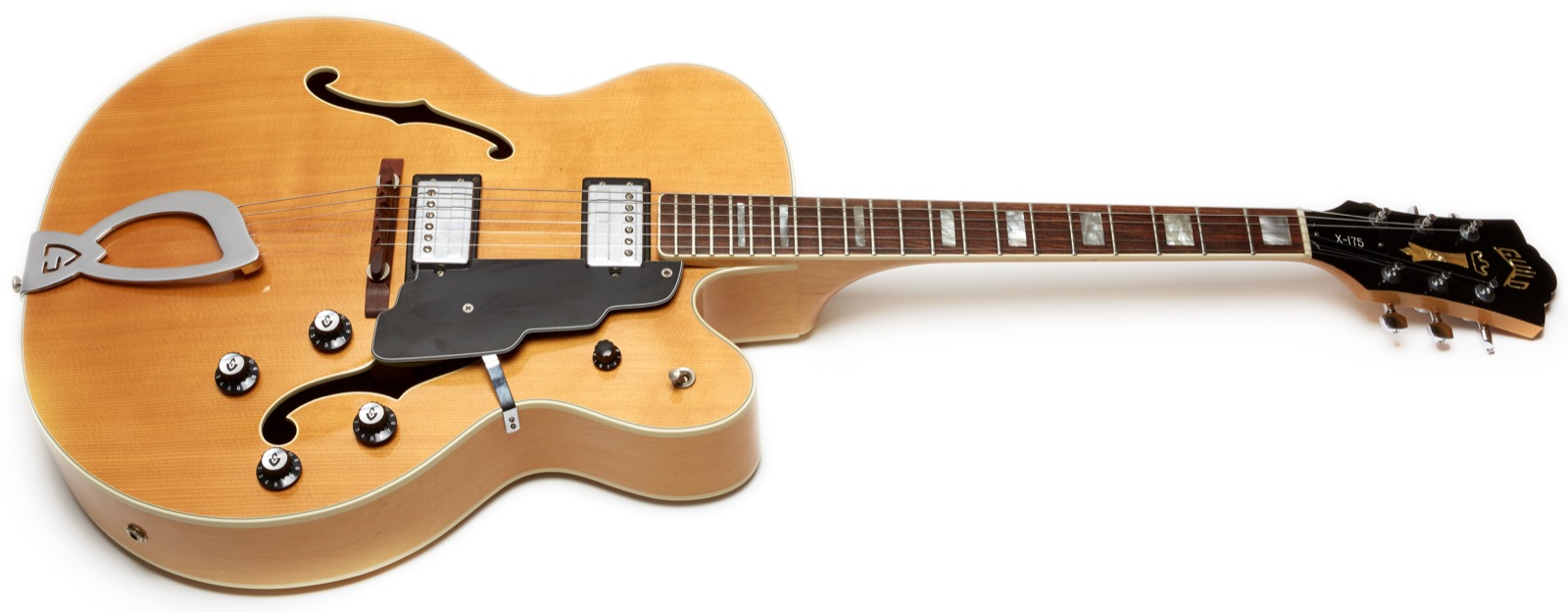
This guitar’s got everything you probably want in a jazz box with the possible deviations from perfection being the laminate construction. If you’re OK with the dual pickup design, then the only way to get a solid top from Guild is with the pricey X700, so this model differs from the X500s mostly in the lack of luxury appointments and the ebony fretboard.
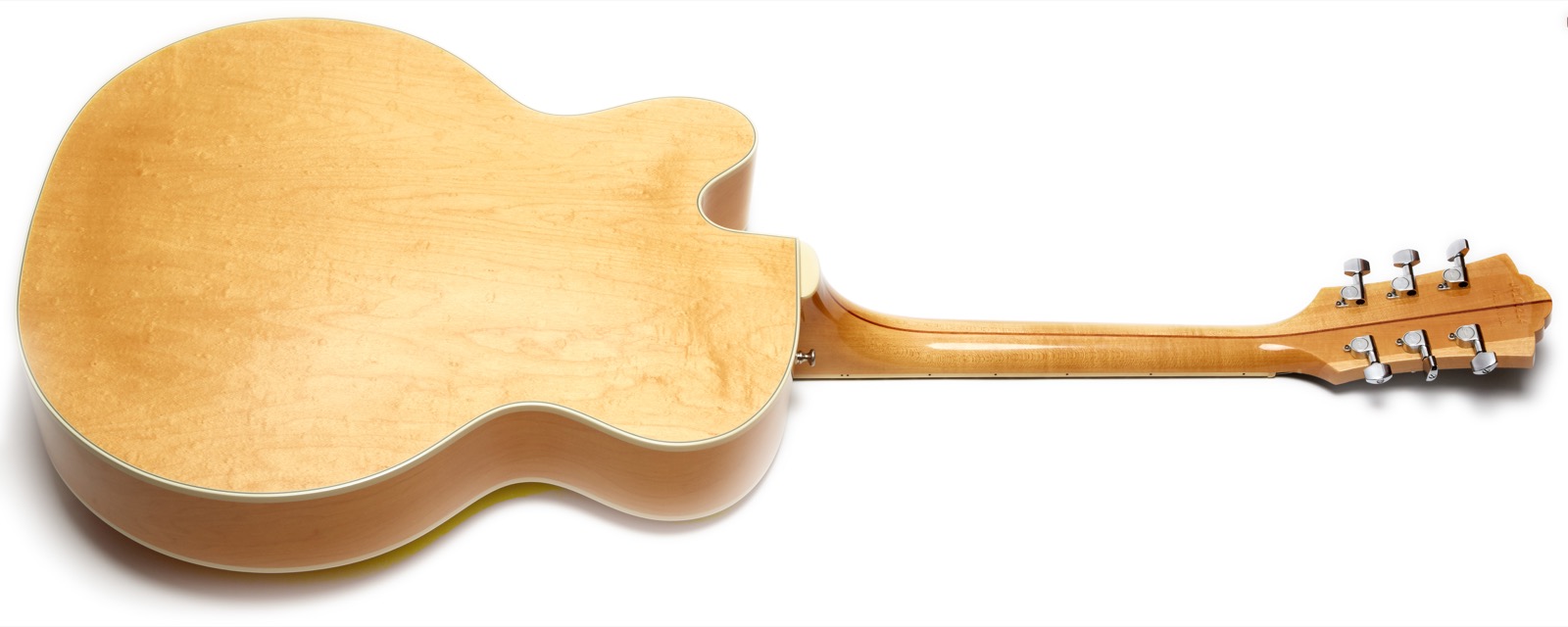
If you’re looking for a jazz-oriented guitar and you don’t want to pay the price for a Guild Benedetto, but you’d also like to own an American guitar from one of the world’s premier guitar makers, find yourself a Westerly Guild X175 because I’m here to tell you that this guitar is an absolute monster in every way.
Donate: PayPal Crypto:
ETH: 0x0AC57f8e0A49dc06Ed4f7926d169342ec4FCd461
Doge: DFWpLqMr6QF67t4wRzvTtNd8UDwjGTQBGs
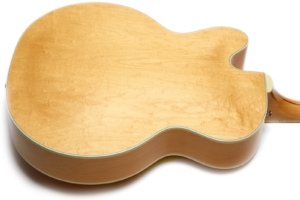

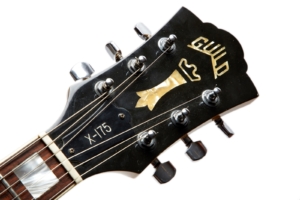
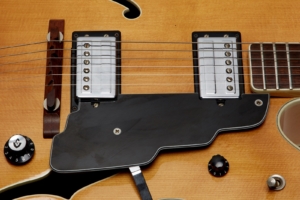
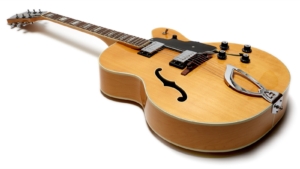
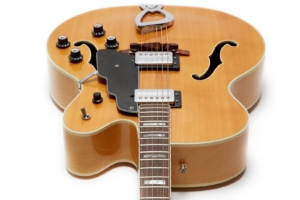
I’ve just bought a 1978 x-175 and have noticed that there is no guild logo on the pickguard, same as the one here in your article (well-done, by the way!). Any idea why some have the plain black guard, and others have the guild emblem/logo on them?
This varies by year produced. Many Guilds in the ’70s and ’80s do not have logos on the pick guard.
MIne has a custom made replacement pickguard, I think the original ones crack near the screw, not sure. Anyone comment on this?
If the guard cracked near the screw then someone probably over tightened it.
I have a 1979 that looks just like the one reviewed here, but with the Guild logo on pickguard. It does have a lot of finish checking and I think must be nitro finish. The acoustic sound is better and better over the years so I now am considering recording with both mic on guitar and amp in closet. I still have original bridge/saddle but opted for roller bridge so I could get intonated better– noticeable on any chord involving first fret, imo.
Hats off for such an enjoyable, thorough and lovely review!! It makes this whole guitar geek experience so much more fun and detailed. I will try to remember to post something with this mic on guitar and amp thing at some point.
Hi. I purchased a 1981 X-175 and I love it. Though a little thicker than I am used to, the neck is super solid and allows for very low action. The amplified sound is rich and has a dark tone I prefer for jazz playing. I would never play standing with a strap though. .. too heavy but balances well on my lap. Thanks for the reviews. I used to have a Guild starfire from the 60’s and it sounded great too. A nice woody tone for being a thin body. Also had a very solid neck that stayed in tune much of the time and was minimally effected . by temp changes.